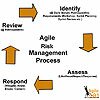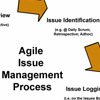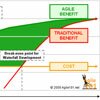Other Recent Articles

Agile Risk Management – Risk Response (3 of 4)
Risk Response is the third stage in the Agile Risk Management process. This stage is preceeded by Risk Identification and Risk Assessment and followed by Risk Review.
27Jul2009 | taraleewhitaker | 0 comments | Continued
Agile Risk Management – Risk Review (4 of 4)
var dzone_style=”2″;Risk Review is the final stage in the Agile Risk Management process. This stage is preceeded by Risk Identification, Risk Assessment and Risk Response.
A Risk is an uncertain event that will impact your chosen path should it be realised. Risks are events that are not currently affecting you – they haven’t happened yet. Once a [...]

Agile Risk Management for Projects and Programmes
Risks are traditionally identified, assessed, responded to and monitored by a Project Manager. In Agile working environments the responsibility for risk management is shared by all involved. There don’t seem to be any official guidelines on how to manage risks within an Agile environment, so I’ll combine my personal views/learning with notes/ideas I’ve found scattered around the web.
27Jul2009 | taraleewhitaker | 2 comments | Continued
Agile Risk Management – The difference between Risks and Issues
A Risk is an uncertain event that could impact your chosen path should it be realised. Risks are events that are not currently affecting you – they haven’t happened yet. Once a risk is realised, it has the potential to become an Issue.
26Jul2009 | taraleewhitaker | 3 comments | Continued
Agile Issue Management for Projects and Programmes
Scrum is great at handling immediate issues or in this case, they’re more commonly referred to as ‘Impediments’…
26Jul2009 | taraleewhitaker | 0 comments | Continued
The Epic Board – An Essential Agile Project Management Tool
I introduced the Epic Board as a programme management tool – a tangible release plan that can help you to plan software development programmes comprising multiple separate projects combined with Business As Usual Activities.
25Jul2009 | taraleewhitaker | 0 comments | Continued
Scrum Meeting Schedule – Two-Week Sprint
So, you’ve heard about Agile and Scrum, your company is sold into the benefits, you’ve had your Scrum Master training, you’re good to go… and now you need to set up all of the meetings! This post will give you a simple overview of the Scrum Meetings and some suggestions for how you might like to schedule/run them.
24Jul2009 | taraleewhitaker | 3 comments | Continued
Scrum Sprint Planning Meetings – Who, What, When, Where, Why
Sprint planning should take place on the first day of the sprint. This session is divided into two parts, the first part is attended by the delivery team and the product manager, whereas the second part is usually only attended by the delivery team.
24Jul2009 | taraleewhitaker | 1 comment | Continued
Self-Funding Projects – A Benefit of Agile Software Development
One of the many benefits of developing software in an iterative way is that you can start realising the benefit of your work before the project is officially ‘finished’.
22Jul2009 | taraleewhitaker | 3 comments | Continued
Value Points – Estimating the relative value of a User Story
Value Points can be used to measure the relative value of stories using a Fibonnaci Sequence. Although not appropriate or particularly necessary in all cases e.g. primarily when you have an omni-present Product Manager, these can be a useful way to prioritise and convey relative importance to a team. This approach becomes increasingly useful as teams scale to cover multiple projects combined with Business As Usual activities.
22Jul2009 | taraleewhitaker | 5 comments | Continued



















